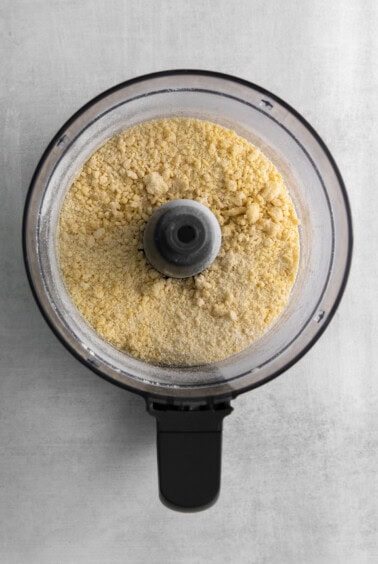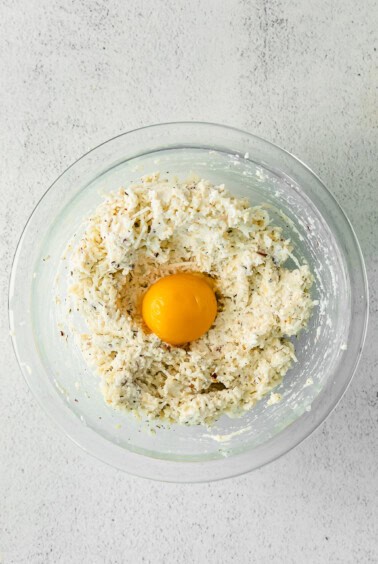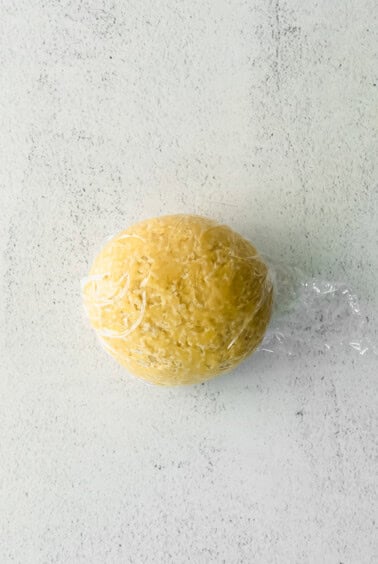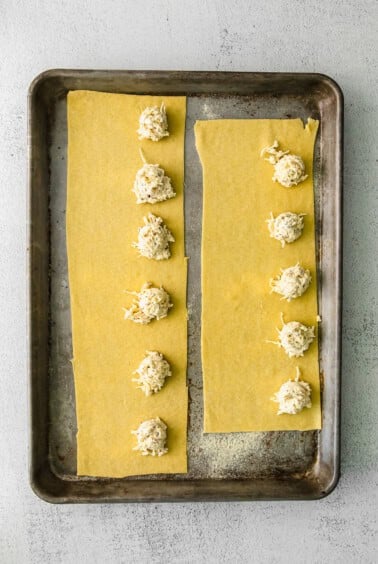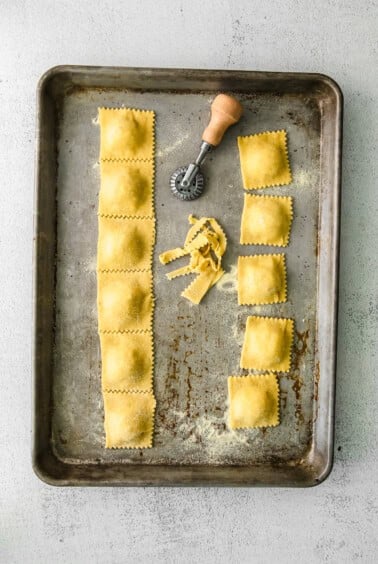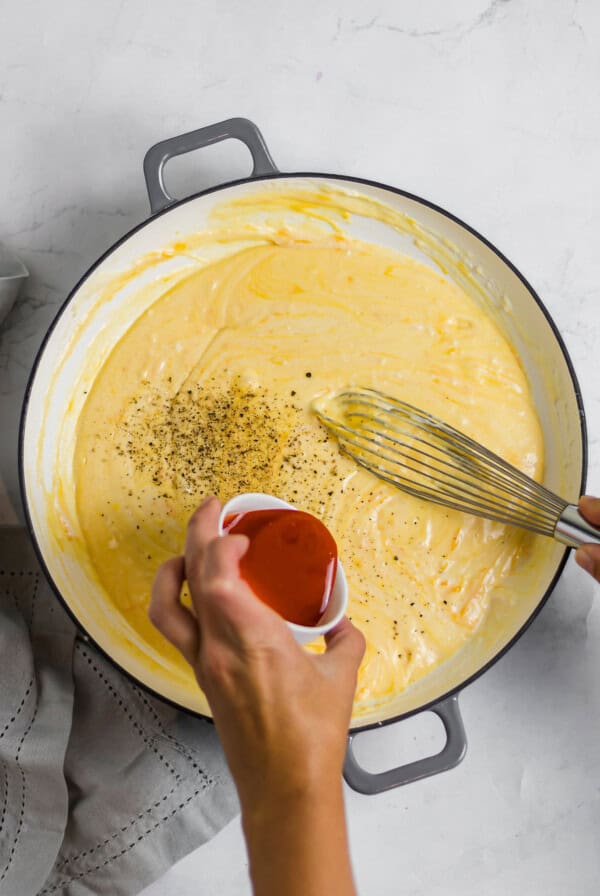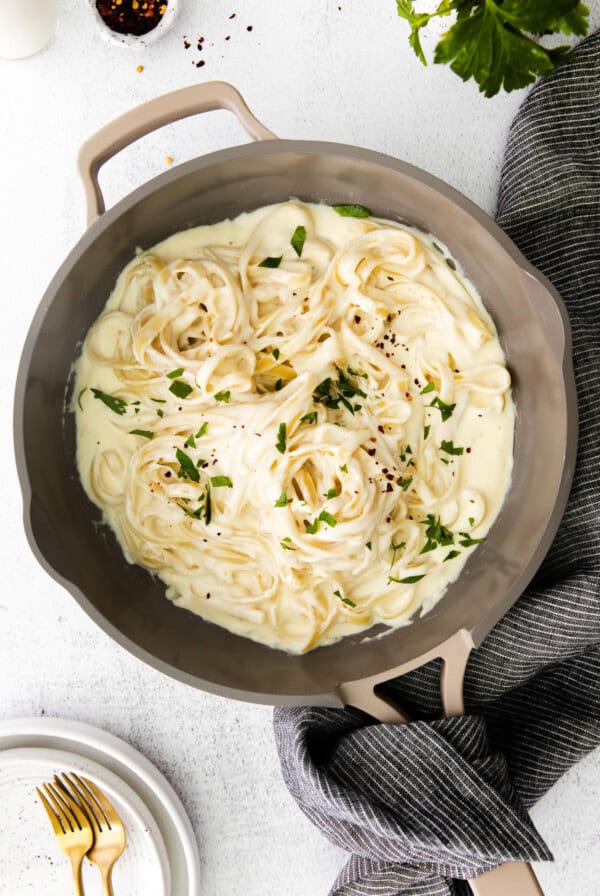How to Make Ravioli
10/18/2023
This post may contain affiliate links. Please read our disclosure policy.
We’re teaching you how to make ravioli in your own kitchen in a few simple steps! First, make the dough and then roll it out. Add little blobs of the cheese mixture and another layer of dough and seal the ravioli shut. Slice and boil!
You’ll love this homemade ravioli recipe because the dough is made with simple ingredients and the three-cheese filling makes them extra gooey!
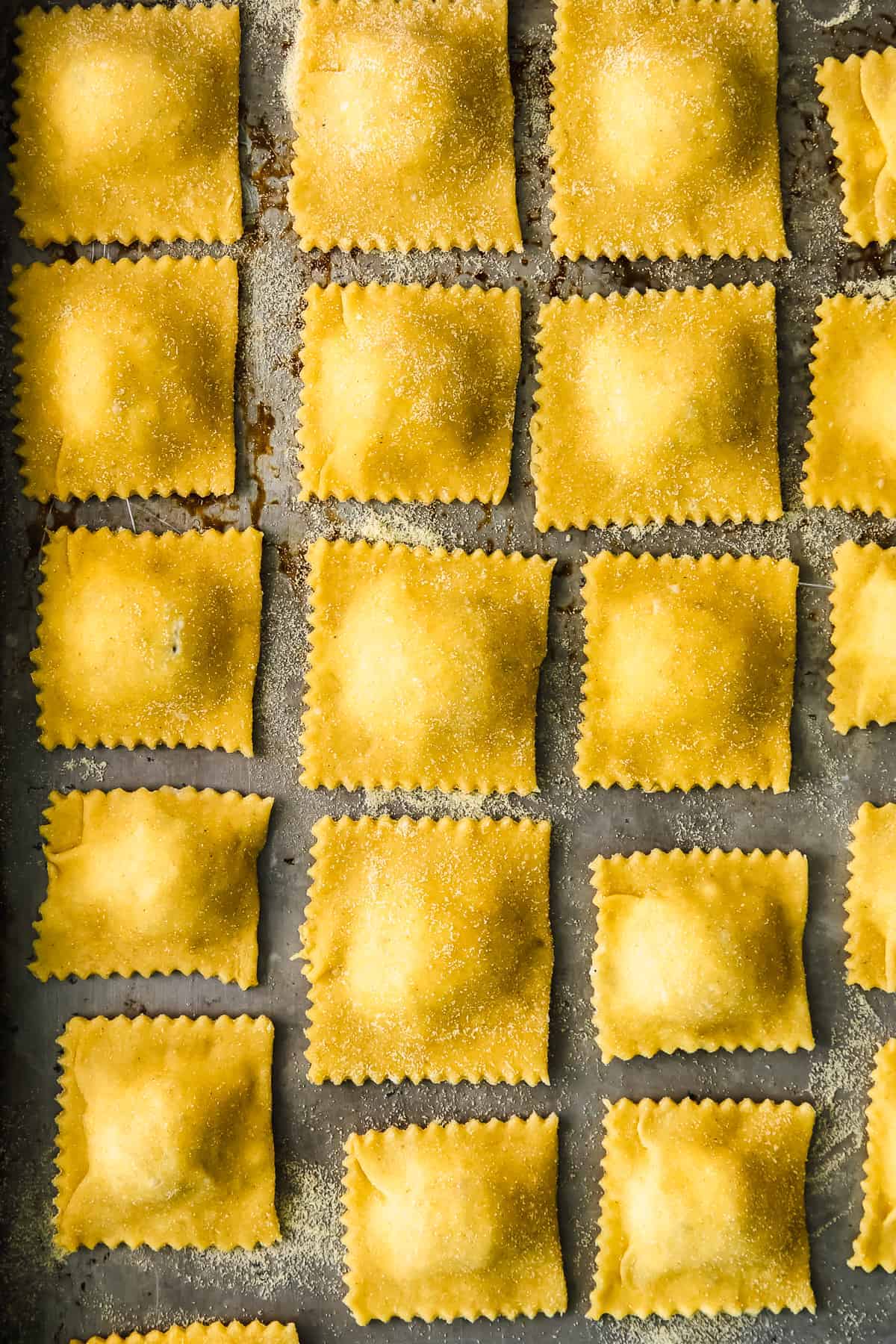
Homemade ravioli is one of our favorites in The Cheese Knees kitchen, and hopefully you’ve already made our goat cheese ravioli and our baked ravioli! Today we’re here to make all your homemade ravioli dreams come true with a simple ravioli recipe 😀
Ravioli can be stuffed with so many delicious fillings, such as meat, cheese and veggies. We tested this basic ravioli recipe with a 3 cheese stuffing (obviously, we’re obsessed with cheese) and kept the ravioli dough quite basic with flour, semolina flour, egg yolks, and olive oil.
We also tested this with a handy dandy rolling pin and our KitchenAid attachment. No fear- we’re giving both options!
What You Need for Homemade Ravioli
FOR THE DOUGH
- All purpose flour: this creates a soft and chewy pasta. If you have 00 (“double O”) flour on hand, that would be even better!
- Semolina flour: this flour adds a bit of bite to the pasta. If you don’t have any, feel free to swap it for additional all purpose flour.
- Salt: a bit of salt seasons the pasta so it doesn’t taste bland!
- Egg yolks: you’ll need these to make the pasta dough rich and smooth. It also helps hold the dough together so it doesn’t crumble apart.
- Olive oil: for a bit of extra richness and flavor to the pasta.
- Water: you’ll need water to help turn the dough together into a smooth, silky dough. It’s important to use cold water so your pasta doesn’t become too warm while it rests.
For the Filling
- Ricotta cheese: this is a classic filling for ravioli — it provides a smooth, subtle filling within the dough. Whole milk ricotta will give you a richer and creamier filling than part-skim ricotta.
- Parmesan cheese: this cheese adds a bit of saltiness and nuttiness to the filling.
- Mozzarella cheese: we love using a finely shredded mozzarella because it melts more smoothly into the filling than larger shreds.
- Garlic powder, Italian seasoning & red pepper flakes: these are simple seasonings to allow the flavors of the cheese to shine. Feel free to swap them out for any seasonings you like — grated garlic, fresh thyme, fresh sage, a pinch of nutmeg– the possibilities are endless.
- Salt: salt helps season the filling so it isn’t too bland. Don’t skip it!
- Egg yolk: adds a bit of extra richness and creaminess to the filling.
Tools required
- Food processor
- Rolling pin/KitchenAid
- Pastry cutter
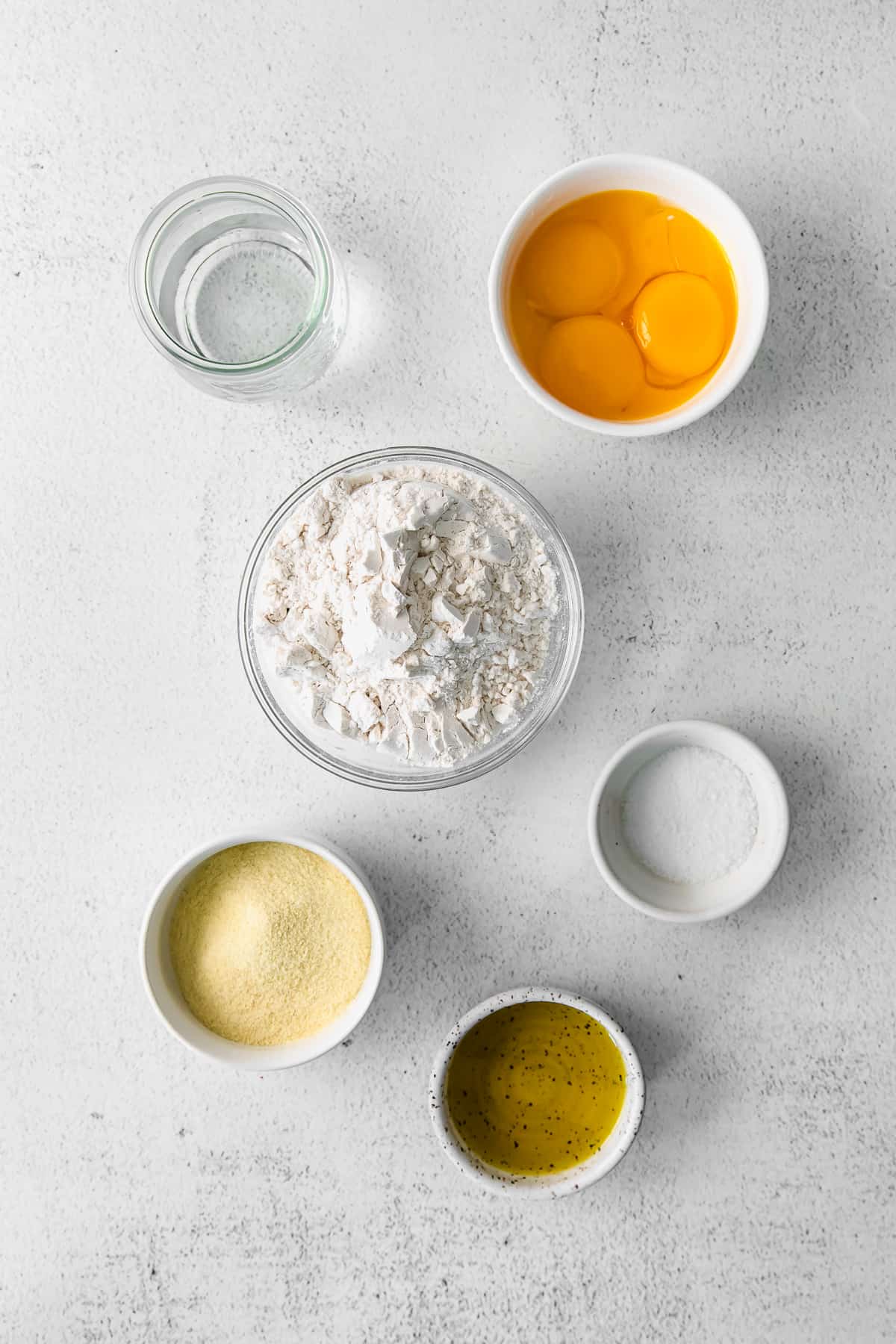
Ravioli Variations
This homemade ravioli recipe calls for ALL THE CHEESE, but feel free to get creative with what you fill your ravioli with:
- Ground meat, such as: ground chicken, pork or beef
- Seafood, such as: lobster, lump crab or shrimp
- Veggies, such as: spinach, mushrooms or leeks

How to Cook Homemade Ravioli
- Bring a pot of salted water to a boil and cook the ravioli until they float.
- This ravioli is delicious with pretty much any sauce — we’re making a few recommendations below!
- Uncooked ravioli can be made up to 24 hours in advance and kept wrapped in plastic in the fridge. Cooked ravioli can be stored in an airtight container in the fridge for up to three days.
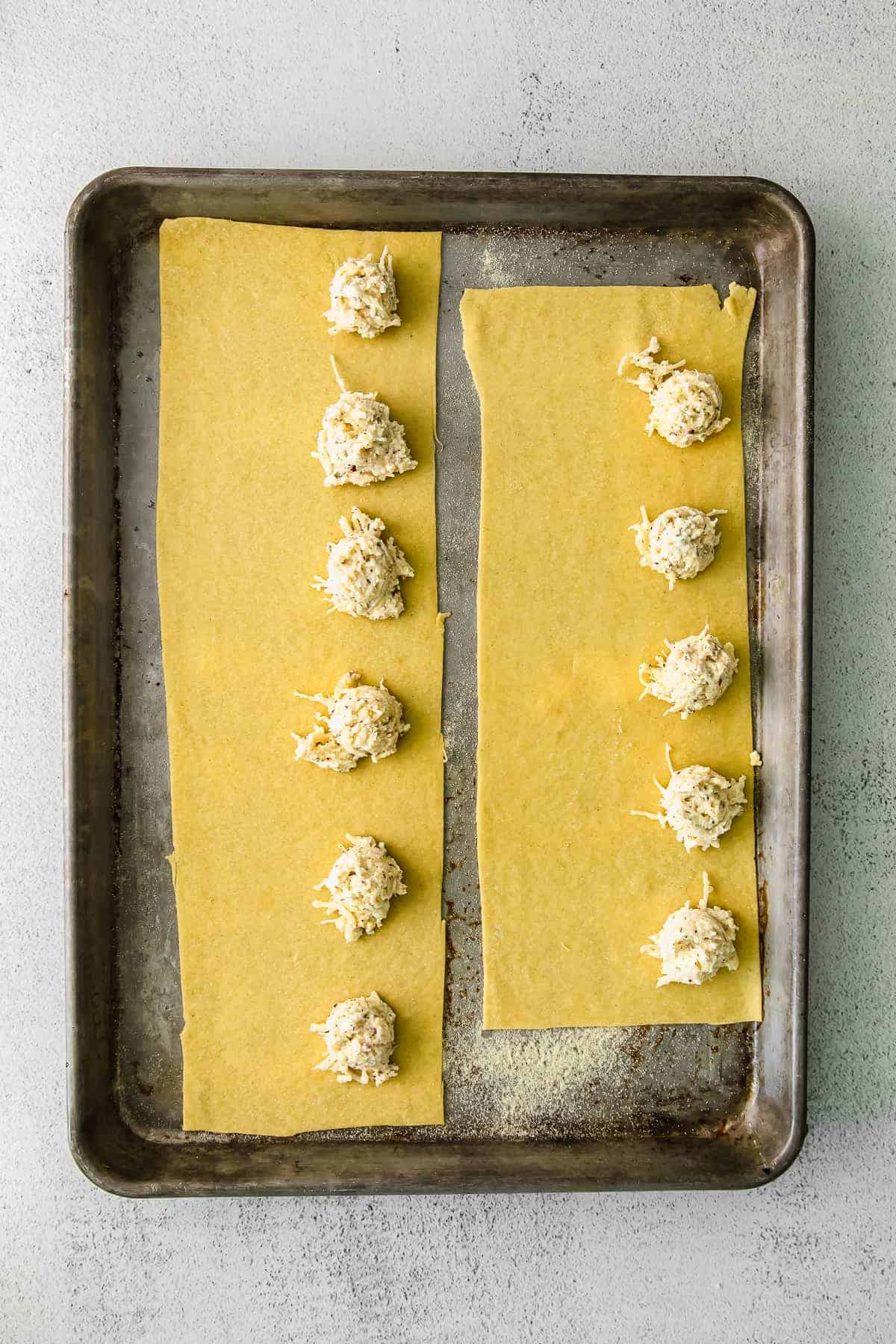
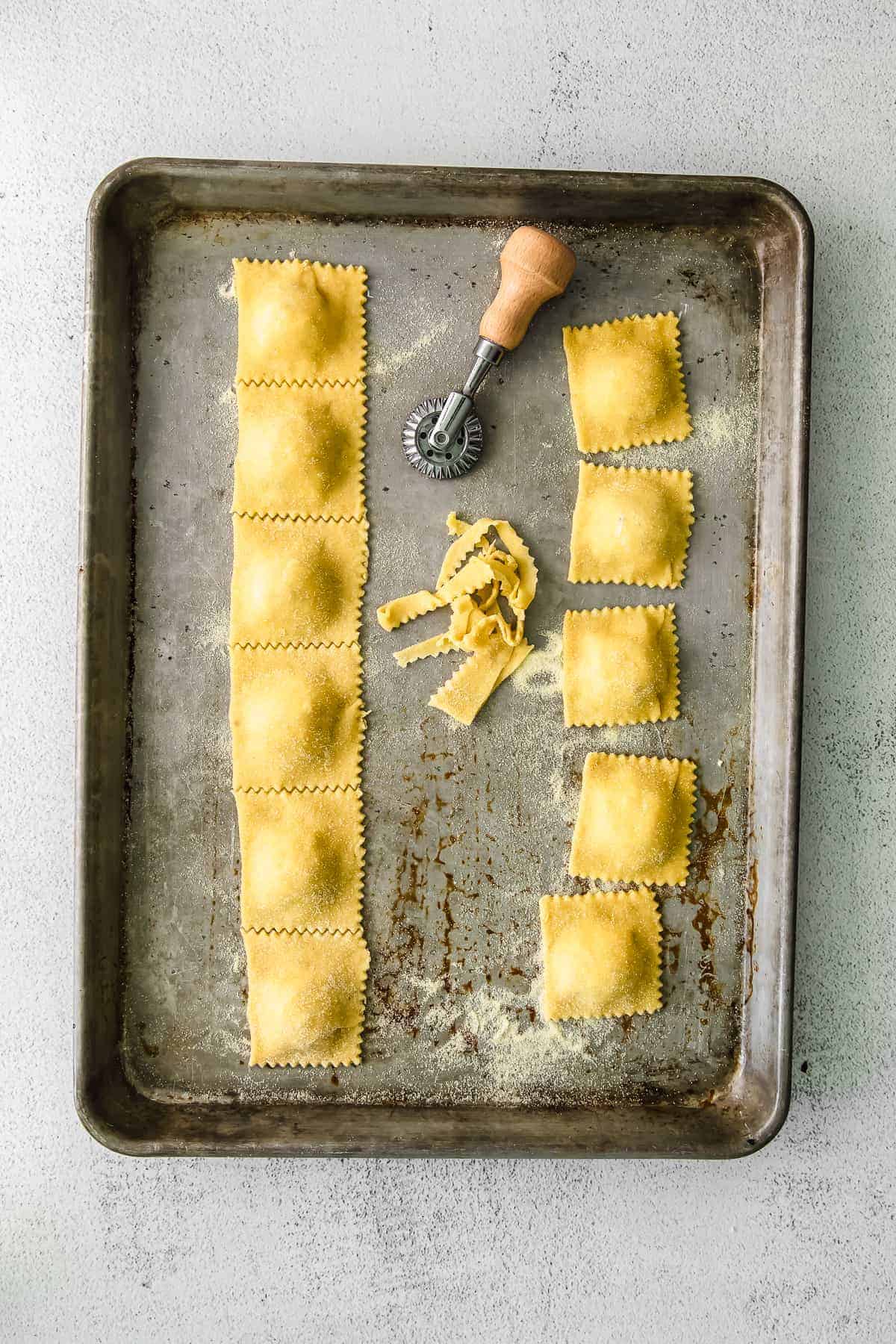
How to Store Homemade Ravioli
To store: drain off the water from the ravioli after boiling, and toss in a little olive oil before storing in the refrigerator in an air-tight container for up to 3 days.
Pro tip: Uncooked ravioli can be made up to 24 hours in advance and kept wrapped in plastic in the fridge.
How to Freeze + Cook
Homemade ravioli can easily be made ahead and frozen! To do this, you’ll cook the ravioli right from frozen.
How to Freeze Ravioli: Flour a baking sheet and lay the ravioli out in one layer not touching, and freeze completely. Dust off the frozen ravioli leaving any excess flour behind, and transfer to a freezer bag.
How to Cook Frozen Ravioli: To cook, bring a large pot of salted water to a boil and cook the ravioli from frozen – they may take up to one additional minute to cook through and rise to the surface of the water. Using a slotted spoon, transfer to a sauce, toss, and enjoy! Easy as that.
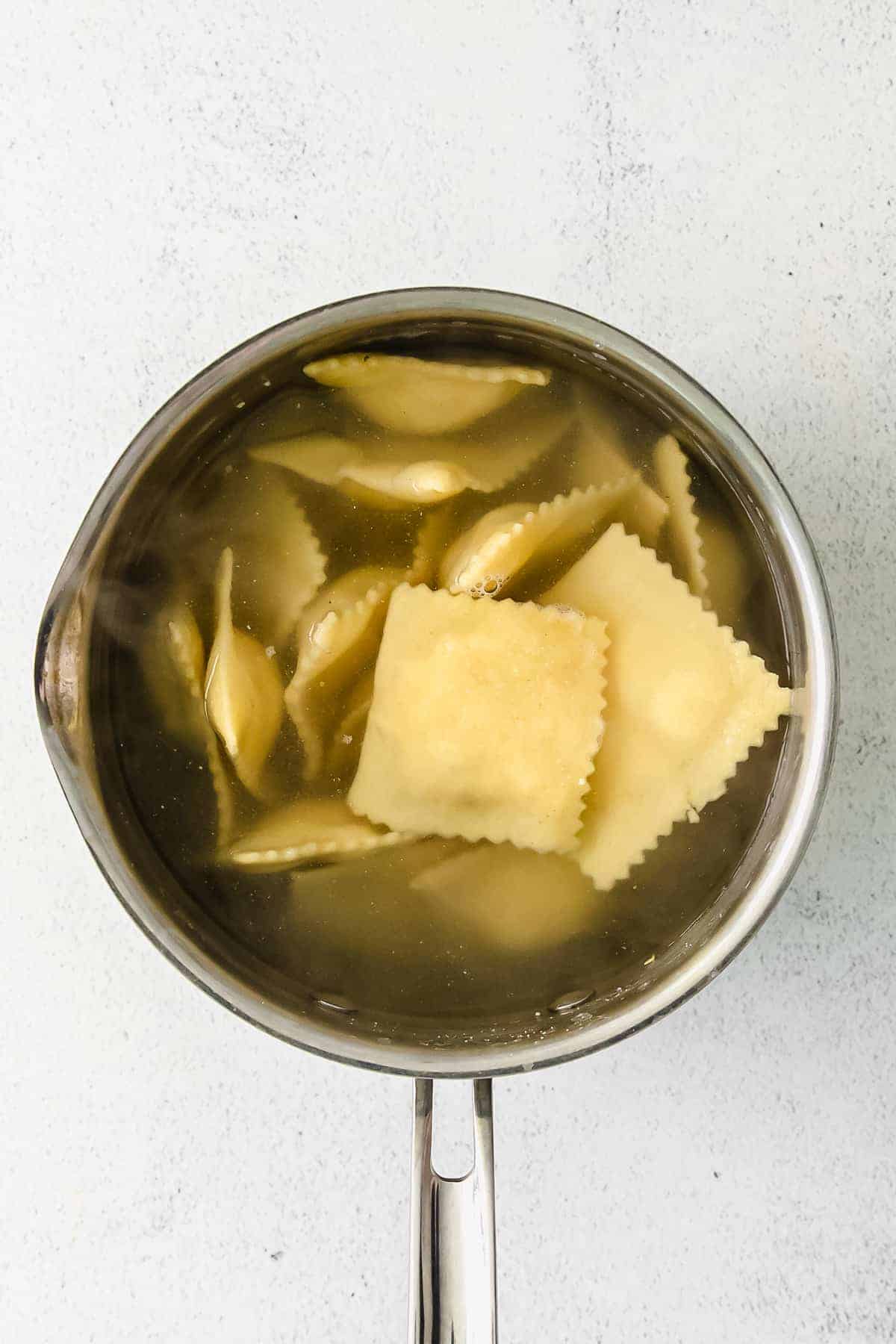
Ravioli Sauce Ideas
We love serving our homemade ravioli with a marinara sauce, fresh basil and more shredded parmesan, but it truly is delicious with almost any sauce — pesto, marinara, Alfredo, vodka sauce — the possibilities are endless! Some of our favorite sauce recipes include:
- Alfredo sauce with cream cheese
- Homemade marinara sauce
- Easy pesto sauce
- Garlic butter sauce
- Mushroom pasta sauce
How to Make Ravioli

Ingredients
For the Pasta Dough
- 1 cup all-purpose flour
- ¼ cup semolina flour
- ½ teaspoon kosher salt
- 3 large egg yolks
- 2 tablespoons olive oil
- ¼ cup cold water
For the Cheese Filling
- 1 cup whole milk ricotta cheese
- 1 cup finely shredded mozzarella cheese
- ½ cup freshly grated parmesan cheese
- 1 teaspoon garlic powder
- 1 teaspoon dried Italian seasoning
- ¼ teaspoon kosher salt
- ¼ teaspoon crushed red pepper flakes
- 1 egg yolk
Instructions
For the Filling
- In a small bowl, mix together the ricotta, mozzarella, parmesan, garlic powder, Italian seasoning, salt, and red pepper flakes.
- Taste and add more salt or red pepper as desired.
- Add the egg yolk and mix to combine. Store in the fridge until ready to use.
For the Pasta Dough
- Add the all-purpose flour, semolina flour, and kosher salt to the bowl of a food processor. Pulse to combine.

- Next, add the egg yolks and olive oil and pulse to combine.

- With the food processor on low, add the cold water and pulse until the dough forms into a loose ball.

- Turn the dough out onto a clean surface and knead just until the dough forms a smooth ball– about 30 seconds. Lightly dust your hands and counter with semolina flour if the dough is sticking.
- Wrap the dough tightly with plastic wrap and set it aside to rest for 30 minutes. While the dough rests, make your filling (below).

- Prepare to roll out your dough and set a bowl of water out that you will be using to seal the ravioli. Next lightly flour your work surface with semolina flour and divide the dough in half. Wrap one half of the dough with plastic wrap and set it aside while you roll the first piece.
- Roll your pasta, according to the manufacturer’s instructions, until it is thin enough to see your fingers through the dough.
- For a KitchenAid pasta attachment: start on the largest setting (#1) and pass the dough through the rollers. Next, move the roller to one setting smaller (#2) and pass the dough through again. Dust with semolina flour as needed. Repeat until you reach setting #5.
- Once the dough is thin enough to see your fingers through, trim it into two equal sized rectangles.
- Scoop your filling onto the bottom half of each piece of dough (about 2 teaspoons per ravioli), making sure to leave enough space to cut your ravioli. You can make them as big or as little as you like!

- Flip the bottom of the dough on top of the filling, dip your fingers in water and wet the outer edge of the ravioli and press them gently to seal. Make sure to press out any air bubbles.
- Cut out the ravioli using a pasta roller or ravioli press and place them on a semolina dusted baking sheet.

- Repeat steps 7-12 with the second piece of pasta dough.
- Once all of the ravioli have been cut, set them aside at room temperature to dry for 30 minutes.
- When ready to serve, bring a pot of salted water to a boil and cook the ravioli until they float– about 2 minutes.

- This ravioli is delicious with any pasta sauce.
Tips & Notes
- If you’re using the KitchenAid pasta attachment: start on the largest setting (#1) and pass the dough through the rollers. Next, move the roller to one setting smaller (#2) and pass the dough through again. Dust with semolina flour as needed. Repeat until you reach setting #5.
- Uncooked ravioli can be made up to 24 hours in advance and kept wrapped in plastic in the fridge. Cooked ravioli can be stored in an airtight container in the fridge for up to three days.
- Freezer instructions: Flour a baking sheet and lay the ravioli out in one layer not touching, and freeze completely. Dust off the frozen ravioli leaving any excess flour behind, and transfer to a freezer bag.
Watch It
Nutrition
Nutrition information is automatically calculated, so should only be used as an approximation.
Don’t forget to tag your posts on social media with the hashtag #cheeseknees, we’d love to see what you’re up to!
